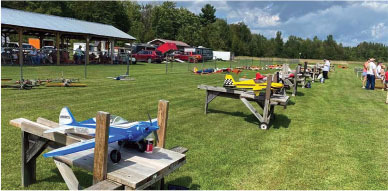Many AMA clubs work to own their flying sites. Site ownership provides both benefits and liabilities. Dealing directly with neighbors and local authorities as a landowner, not to mention potential property taxes, creates added responsibilities, If it’s done right, club flying site ownership provides added benefits and autonomy. Here are examples of three such District II clubs that own their flying fields.
The Plattsburg Radio Aero Modelers (PRAM) took advantage of buying their flying site nearly 30 years ago. When the club decided to add an RC car track to the field, there was not a landowner to ask permission.

The spacious PRAM field.

Training at the PRAM club.
As the landowner, the club made the decision and created the track. Several years ago, PRAM decided to move the flying field entry road farther away from the runway to increase safety. Again, it was a decision that the club made on its own.
The Southern Tier Aero Radio Association (STARS), in Cuba, New York, is another club that owns its flying site. It is also designated as an AMA historic site by the AMA Heritage Program. The facility has running water, a restroom, and power for both club operations and RV campers!

The STARS Historic Site marker.
The STARS club recently acquired some land adjoining their field. The purchase was prudent in that it not only created an additional buffer from neighbors, but it also provided for potential use by the club.
The Sky Rovers Radio Controlled Flying Club, located in Phelps, New York, is another District II club that purchased its flying site many years ago. The club has been extremely active throughout the years in flying site and community activities. With the autonomy of owning their own flying field, the club has been able to make numerous improvements, including a large storage barn and drainage projects. Each year, the club invites the community to come out and discover model aviation!

The Sky Rovers large storage building.
The three previously mentioned clubs are fortunate to own their own facilities where they make continuous improvements. Of course, not every club can own its own flying site, particularly in urban settings where the only flying site options are public lands; however, all clubs should benefit from the possibilities of what they can do at their existing site and consider laying plans to secure their future with their own properties.
If you’d like information about various methods that our clubs have used to arrange for the purchase of their flying sites, please drop me a line.
Remember, it’s not about what you fly, it’s about the friends you make.